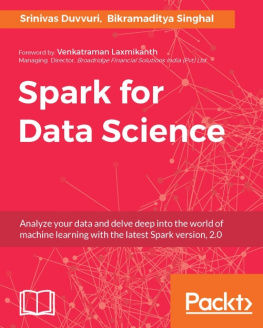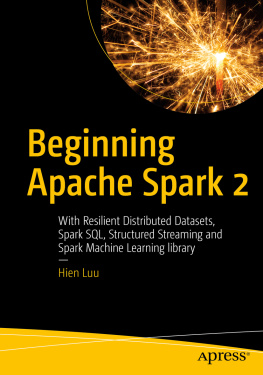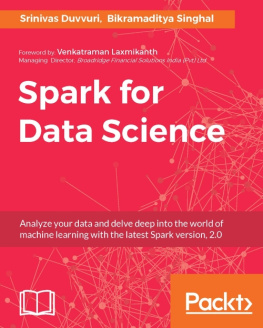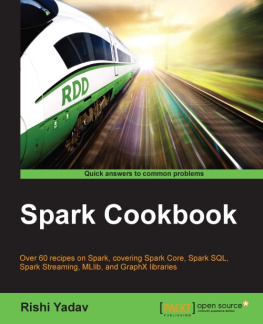Bikramaditya Singhal - Spark for Data Science
Here you can read online Bikramaditya Singhal - Spark for Data Science full text of the book (entire story) in english for free. Download pdf and epub, get meaning, cover and reviews about this ebook. year: 2016, publisher: Packt Publishing, genre: Computer. Description of the work, (preface) as well as reviews are available. Best literature library LitArk.com created for fans of good reading and offers a wide selection of genres:
Romance novel
Science fiction
Adventure
Detective
Science
History
Home and family
Prose
Art
Politics
Computer
Non-fiction
Religion
Business
Children
Humor
Choose a favorite category and find really read worthwhile books. Enjoy immersion in the world of imagination, feel the emotions of the characters or learn something new for yourself, make an fascinating discovery.
- Book:Spark for Data Science
- Author:
- Publisher:Packt Publishing
- Genre:
- Year:2016
- Rating:4 / 5
- Favourites:Add to favourites
- Your mark:
Spark for Data Science: summary, description and annotation
We offer to read an annotation, description, summary or preface (depends on what the author of the book "Spark for Data Science" wrote himself). If you haven't found the necessary information about the book — write in the comments, we will try to find it.
Analyze your data and delve deep into the world of machine learning with the latest Spark version, 2.0
About This Book
- Perform data analysis and build predictive models on huge datasets that leverage Apache Spark
- Learn to integrate data science algorithms and techniques with the fast and scalable computing features of Spark to address big data challenges
- Work through practical examples on real-world problems with sample code snippets
Who This Book Is For
This book is for anyone who wants to leverage Apache Spark for data science and machine learning. If you are a technologist who wants to expand your knowledge to perform data science operations in Spark, or a data scientist who wants to understand how algorithms are implemented in Spark, or a newbie with minimal development experience who wants to learn about Big Data Analytics, this book is for you!
What You Will Learn
- Consolidate, clean, and transform your data acquired from various data sources
- Perform statistical analysis of data to find hidden insights
- Explore graphical techniques to see what your data looks like
- Use machine learning techniques to build predictive models
- Build scalable data products and solutions
- Start programming using the RDD, DataFrame and Dataset APIs
- Become an expert by improving your data analytical skills
In Detail
This is the era of Big Data. The words Big Data implies big innovation and enables a competitive advantage for businesses. Apache Spark was designed to perform Big Data analytics at scale, and so Spark is equipped with the necessary algorithms and supports multiple programming languages.
Whether you are a technologist, a data scientist, or a beginner to Big Data analytics, this book will provide you with all the skills necessary to perform statistical data analysis, data visualization, predictive modeling, and build scalable data products or solutions using Python, Scala, and R.
With ample case studies and real-world examples, Spark for Data Science will help you ensure the successful execution of your data science projects.
Style and approach
This book takes a step-by-step approach to statistical analysis and machine learning, and is explained in a conversational and easy-to-follow style. Each topic is explained sequentially with a focus on the fundamentals as well as the advanced concepts of algorithms and techniques. Real-world examples with sample code snippets are also included.
Downloading the example code for this book. You can download the example code files for all Packt books you have purchased from your account at http://www.PacktPub.com. If you purchased this book elsewhere, you can visit http://www.PacktPub.com/support and register to have the code file.
Bikramaditya Singhal: author's other books
Who wrote Spark for Data Science? Find out the surname, the name of the author of the book and a list of all author's works by series.










![Frank Kane [Frank Kane] - Hands-On Data Science and Python Machine Learning](/uploads/posts/book/119615/thumbs/frank-kane-frank-kane-hands-on-data-science-and.jpg)

